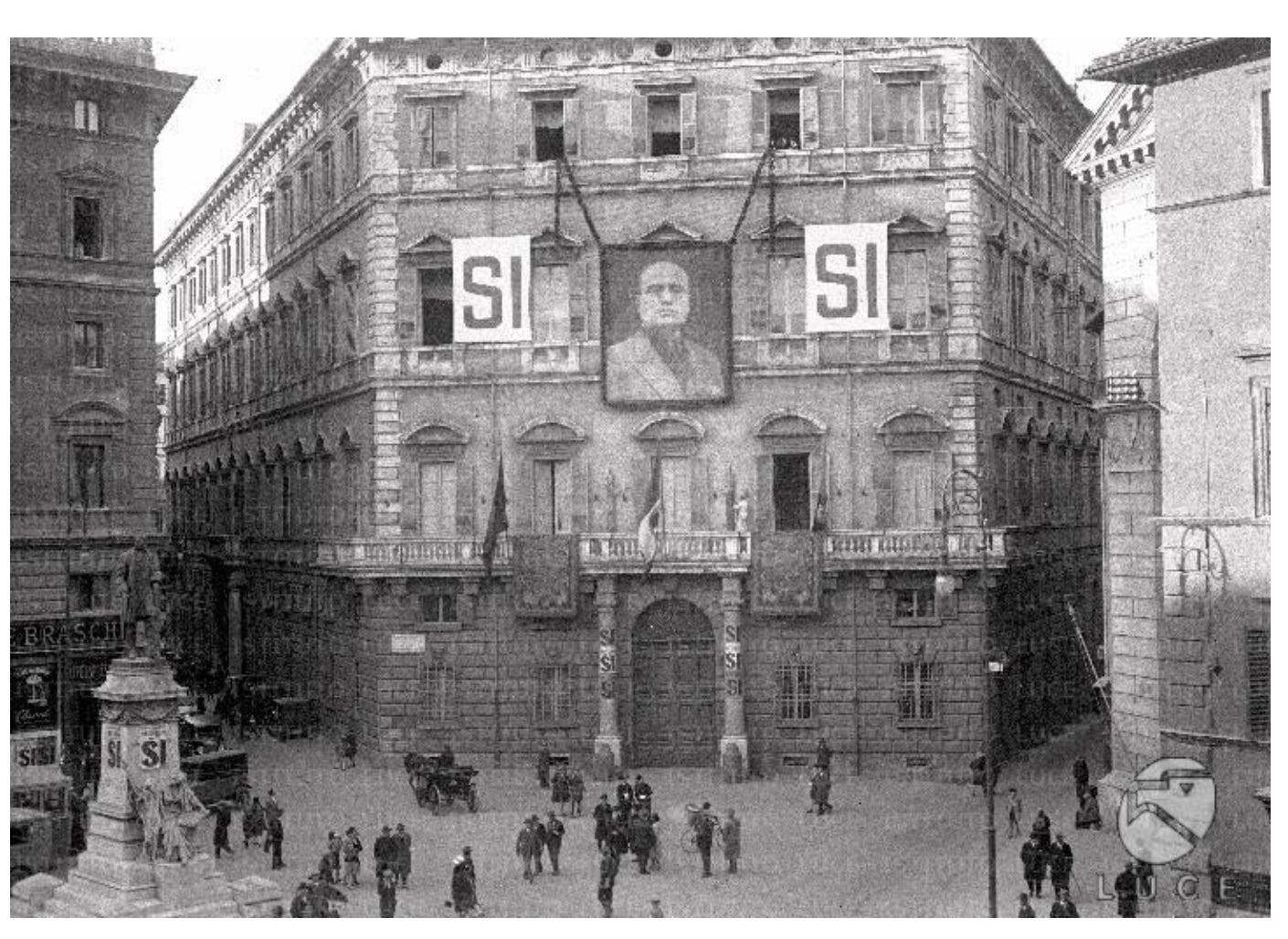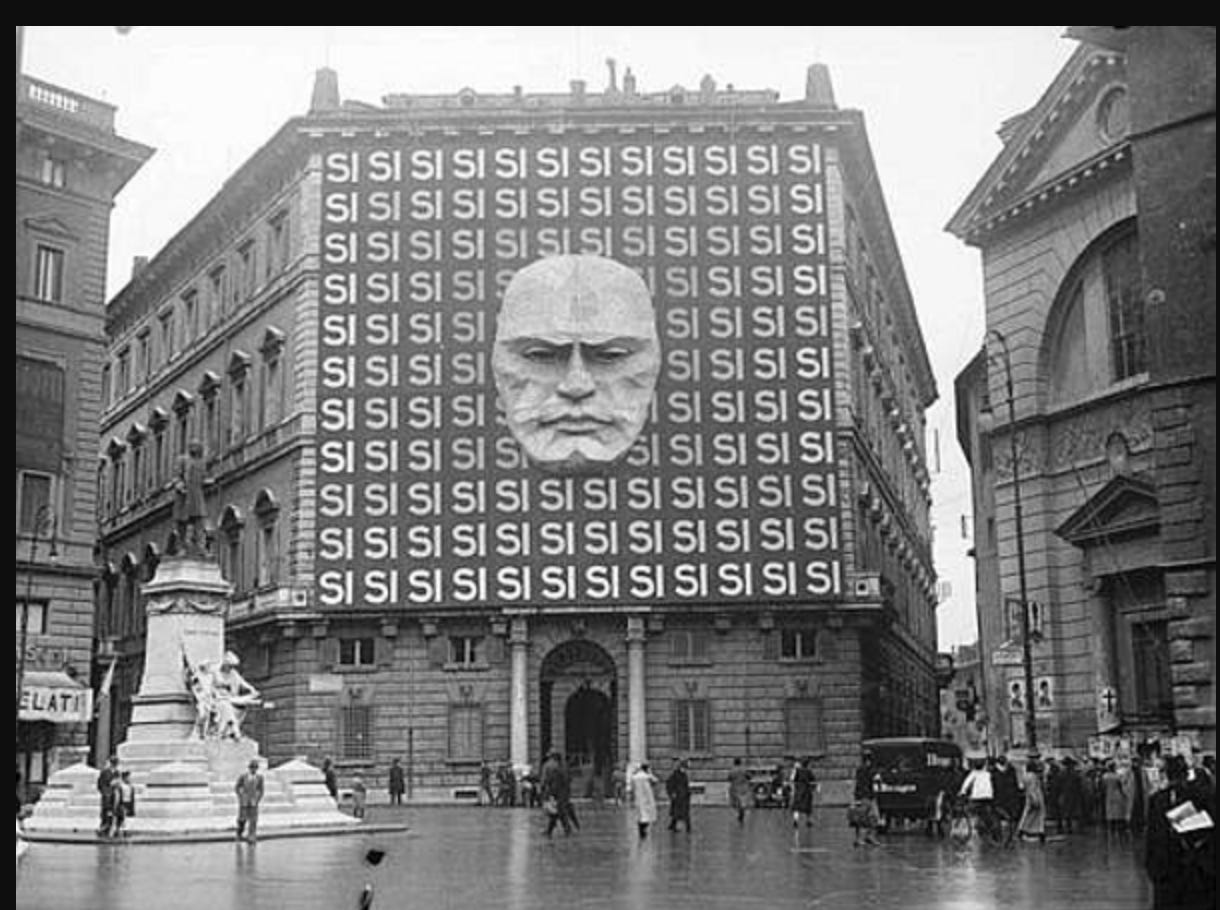Vote Yes or Else: The Fascist Idea of Elections
Mussolini's fake plebiscites are all too familiar
In the 20th century, the practice of holding elections was often used to determine whether a country could be classified as a democracy. Today, as "electoral autocracies" take hold around the world, that's no longer the case. Many illiberal leaders come to power through elections and then manipulate the electoral system to get the results they need to stay in office.
Keeping elections going covers their despotism with a veneer of freedom, which is useful for getting foreign loans and, in the case of Hungary's Viktor Orbán, European Union benefits and funds. Plebiscites and referendums are also used by leaders to normalize seizures of foreign territory—no matter that voters may cast their ballots under duress, as reportedly happened to some Russians who “approved” Russian President Vladimir Putin’s annexation of Luhansk and other occupied Ukrainian territories.
Autocrats who feel that an upcoming election may threaten their power won’t hesitate to game the competition by shutting down or buying out opposition media outlets and finding ways to silence rivals. In advance of the 2023 presidential contest, Turkish President Recep Tayyip Erdogan is sentencing popular Istanbul Mayor Ekram Imamoglu, the only man who could beat him, to several years in jail. "Here we have a ballot box...the democracy gets its power from the people. It's what we call national will," Erdogan had claimed to CNN in 2018, denying he was a dictator.
Had Italian Fascist despot Benito Mussolini been listening from the grave, he would have approved of Erdogan’s statement. Il Duce staged sham elections in 1929 and in 1934 which were designed to demonstrate popular approval for his regime to Italians and the world.
In 1929, Fascism was entering a new stage, with mass organizations for workers, youth, and others bringing the regime's repressive actions into villages and towns under the guise of "going toward the people," as the Fascist slogan went.
Mussolini wanted to shake up the Chamber of Deputies (the equivalent of the U.S. House) and weed out insufficiently politicized or loyal politicians. So, he put on a plebiscite, asking voters to approve or reject a single slate of individuals who had been nominated by Fascist government associations and institutes. Unsurprisingly in a one-party state that had already killed thousands of Italians, the results were 98.34% YES and 1.57% NO.
Yet those NO votes show that some still felt they could risk expressing their real opinions. In 1929, Italy had only been a dictatorship for four years, and Mussolini still had not fully broken leftist resistance networks.
By 1934, all that had changed, and with it the possibility of opposition, as the story of the second plebiscite shows. Mussolini was then in full international anti-Communist idol mode. He was beloved (and funded) by influential Americans, and had a syndicated column in the U.S. courtesy of the right-wing Hearst media conglomerate. When Adolf Hitler shut down German democracy in 1933 and began to menace Europe, Il Duce played the role of "moderate peacemaker," shepherding Hitler (who looked up to him) to sign the Four Power Pact with Britain, France, and Italy in 1933.
Mussolini needed to keep this reputation as “the good Fascist” as he geared up to invade Ethiopia, a League of Nations member. So he took no chances when he shook up Italian political elites in 1934 in advance of the war. Once again Italian voters could vote YES or NO on a single list of nominees from Fascist organizations. Denouncing these "totalitarian 'elections,'" the Italian anti-Fascist historian in exile Gaetano Salvemini considered why Mussolini did not just abolish the Chamber of Deputies altogether, coming to a conclusion that will sound familiar to many today:
"If Italy did not from time to time give to the world the appearance of national elections...no American banker could induce the American investors to underwrite an Italian loan, because the American newspapers could not affirm that Mussolini really represents the Italian people, as is demonstrated by regular national 'elections'."
The result of the 1934 plebiscite --99.85% YES, and only .15% NO--suggests the toll of increased repression. Mussolini may have been more popular abroad in 1934, but at home Fascism had developed a formidable secret police and informer apparatus. Everyone knew what happened to those who expressed any form of public dissent against the regime.
It helped that voting was done under Fascist "poll watchers," (squadrists in black shirts), as this 1934 Fascist newsreel shows. Even a member of the clergy looked at the camera before he inserted his ballot —and made sure to perform the Fascist salute after. Fascist official Edmondo Rossoni, gesticulating wildly in the Mussolini manner, reminded people that they were actually saying YES or NO to Mussolini. The marching band seen on screen celebrates an outcome already preordained.
The visual propaganda produced for the 1929 and 1934 elections shows the increased atmosphere of threat. Both posters depict the Palazzo Braschi in Rome, headquarters of the Fascist federation. The 1929 design is understated and Mussolini wears a neutral expression.
The 1934 version is graphically striking and also terrifying: Mussolini's face is depicted as a kind of death mask. Palazzo Braschi is in the center of Rome, and Italians would see this nightmarish apparition while they waited for the bus or went to the market. The .15% opposition means that the message of "vote YES or else" had been received.
In 1934, as in the 2020s, the purpose of “elections” in authoritarian states is to consolidate the power of the leader by confirming to the world that his people have given him a mandate to govern. Mussolini was well aware of this function as he planned the 1929 election that would strip many powerful officials of their parliamentary positions. [A] revolution may consent to be endorsed by a plebiscite, but never to be overthrown by it," he stated in a December 1928 speech, letting deputies know that he would tolerate no opposition from malcontents. Today's autocrats, who are busy with their own sham elections meant to keep themselves perpetually in power, would surely agree with him.






Adrian Fontes, newly elected Arizona Secretary of State, used the word "fascist" many times last night on MSNBC to describe the MAGA "terrorists," a word he also used, to describe those who were intimidating honest, hardworking, election officials in many Arizona counties to resign. Their resignations cost the State years of experience. His office needed help, he said, to bolster the effort to counter the MAGA people. How to help? is my question.
The image of the Palazzo Braschi, Rome circa 1934 is nightmarish, something you'd imagine in a dystopian novel. Only this was real and what's brewing in the United States and other countries leaning into fascism is equally real.
The voting situation across the US is getting progressively worse with the GOP's denial of election results and increasingly restrictive voting regulations, all in the name of voting integrity. Which is actually a bid to restrict access, demoralize voters so only the 'right' people go to the polls and/or only the 'right' votes are counted.
It's going to be a continuous slog to push against the MAGATs but push we must while highlighting the excesses we're already seeing in Florida, Texas, etc. with book bans (which are really idea/history bans), the retooling of educational facilities to weed out 'renegade' teachers and librarians and the continuous propaganda that generates and feeds the disinformation and outrage machine.
Time is running out to expose the leaders, backers, donors of the movement for what they are: fascists, Christian Nationalists, anti-democratic ideologues and bigots, no different from what's existed before, merely wrapped this time in the American flag.
I'm glad Adrian Fontes used the word fascist. Republicans will howl, of course, but the time has passed for being timid or polite. MAGA leaders are arsonists hoping to burn the country to the ground. If they can't get their way, they're quite willing to use violence. January 6th was a dark preview.
Which is why as a pro-democracy coalition, we must fight now and into the foreseeable future. We fight with our voices, our votes, our interactions with others. Some people will be more active than others but we all need to engage, do what we're capable of doing to push against the lies, the fabrications, the assault on reason.
We fight while we still can.